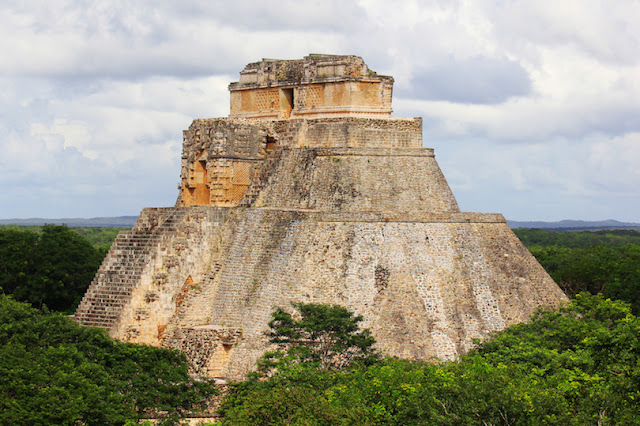The ancient Mayan city of Uxmal is one of the most historically and culturally significant attractions in Mexico. Roughly 55 km (35 miles) south of Merida in Yucatan, the city was constructed primarily in the ninth century. Uxmal was once the capital of the region, and it is a prime example of Puuc architecture. Various stone levels, along with elaborate stonework, gives the pyramid structures a grand appearance. Not to be missed is the Magician’s Pyramid, the tallest of the pyramids at Uxmal.
Uxmal (Yucatec Maya: Óoxmáal [óˑʃmáˑl]) is an ancient Maya city of the classical period in present-day Mexico. It is considered one of the most important archaeological sites of Maya culture, along with Palenque, Chichén, and Calakmul in Mexico, Caracol and Xunantunich in Belize, and Tikal in Guatemala. It is located in the Puuc region and is considered one of the Maya cities most representative of the region's dominant architectural style. It has been designated a UNESCO World Heritage Site in recognition of its significance.
It is located 62 km south of Mérida, capital of Yucatán state in Mexico. Its buildings are noted for their size and decoration. Ancient roads called sacbes connect the buildings, and also were built to other cities in the area such as Chichén Itzá in modern-day Mexico, Caracol and Xunantunich in modern-day Belize, and Tikal in modern-day Guatemala.
Its buildings are typical of the Puuc style, with smooth low walls that open on ornate friezes based on representations of typical Maya huts. These are represented by columns (representing the reeds used for the walls of the huts) and trapezoidal shapes (representing the thatched roofs). Entwined snakes and, in many cases two-headed snakes are used for masks of the rain god, Chaac; its big noses represent the rays of the storms. Feathered serpents with open fangs are shown leaving from the same human beings. Also seen in some cities are the influences of the Nahua, who followed the cult of Quetzalcoatl and Tlaloc. These were integrated with the original elements of the Puuc tradition.
The buildings take advantage of the terrain to gain height and acquire important volumes, including the Pyramid of the Magician, with five levels, and the Governor's Palace, which covers an area of more than 1,200 m2 (12,917 sq ft).
The Magic and History of Uxmal
The name Uxmal means ‘thrice-built’ in Mayan. This name refers to the construction of its highest structure, the Pyramid of the Magician which was built on top of existing pyramids. In this case, five stages of construction have been found.
Uxmal was one of the largest cities of the Yucatán peninsula on the Ruta Puuc (Puuc Route), and at its height was home to approximately 20,000 Maya. Uxmal and other surrounding Puuc sites flourished in the Late Classic Period (around 600-900 AD) before they were overruled by neighboring settlements. The rulers of Uxmal are also thought to have presided over the nearby settlements of Kabah, Labná and Sayil. There are several sacbes (white roads of the Maya) connecting the nearby sites.
Uxmal Architecture -A Notable Asset of this Mayan Region
In our travels we have experienced varying architectural styles throughout the Yucatan. Many Maya sites were built using a combination of these styles. Uxmal and other sites located on the Puuc Route are comprised of only one architectural influence that comes directly from the Maya.
Puuc architecture is easily identified. The lower sections of the buildings are plain, have rounded corners, and are made of small arches or entrance ways. Upper sections are highly decorated and reflect a distinct layering of stone work. Ornate carvings include serpents, lattice work, and pillars.
Puuc construction used a system of cut veneer stones set into a concrete core. This is an improvement over the previous construction method of using stones held together with plaster. This advanced construction method allowed for slightly larger and more stable interior rooms and may account for the excellent condition of many of the thousand-year-old buildings at Uxmal, Labna, Sayil and Kabna.
The Importance of the God of Rain
Chac was the Mayan god of rain, and the honored god at Uxmal due to the lack of natural water supplies in the city. Unlike other archeological sites in the Yucatan, Uxmal does not have an on-site cenote (fresh water source). Although the Yucatán has few surface rivers, most Maya cities, including Chichén Itzá, used cenotes to access underground water, however there were no cenotes at Uxmal. Instead, it was necessary to collect water in chultunes, or cisterns, built in the ground.
Reference:
1. touropia
2. wikipedia
3. locogringo










No comments:
Post a Comment